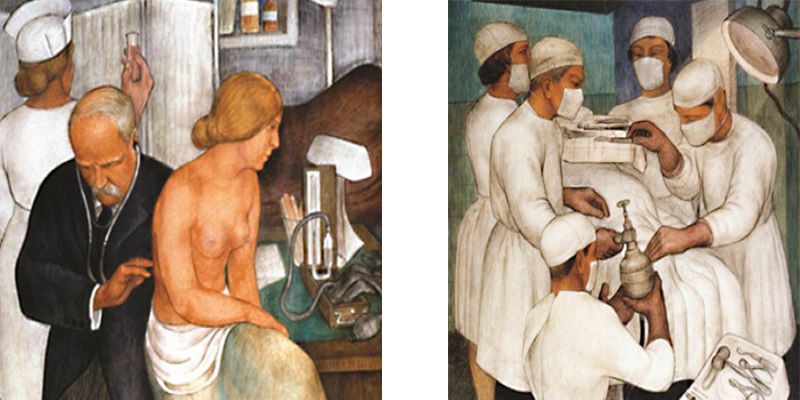Victor Mikhail Arnautoff (1896-1979) was a Russian-born painter and Stanford art professor for over 20 years. The son of a Russian Orthodox priest, he showed talent from an early age and intended to make art his career – but history had other ideas. When World War I began, he enrolled in military school and held leadership positions in the army and was decorated for his service. After the Bolshevik Revolution, he escaped into northeastern China for five years, where he met and married Lydia Blonsky.
Arnautoff arrived in San Francisco in 1925 on a student visa to attend the California School of Fine Arts, where he became active in the city’s leftist arts scene. As his visa expired, he moved to Mexico in 1929 and worked as Diego Rivera’s assistant, where he learned the difficult art of fresco painting and was influenced by Rivera’s political views. When Rivera left temporarily to paint a mural in the U.S., Arnautoff was left in charge of the murals at Palacio Nacional in Mexico.
The Arnautoffs moved back to San Francisco in 1931. A patient of the Palo Alto Medical Clinic, he received his first American commission to paint frescoes on the Roth Building. He was paid the same rate as a plasterer ($5 a day) for his fine art, perhaps in an effort to get his career started here. It worked; he received many commissions and became one of the country’s foremost muralists.
The frescoes he created for the clinic (still visible at 300 Homer Avenue) commemorate advances in ancient and modern medical practices (including the X-ray). There are four color panels representing modern medicine, nine black and white (grisaille) panels depicting medical practices of the past, and four sepia-toned medallions on the arcade depicting prominent scientists.
One of the 17 frescoes caused a minor scandal because a female patient was depicted partially undressed. Onlookers from as far away as San Francisco drove slowly along Homer Avenue to view the frescoes, causing traffic jams and provoking a threat from clinic surgeon Fritz Roth that he wouldn’t move in until the walls were whitewashed. (The furor abated and the frescoes weren’t painted over.)
His next project was to supervise the team of artists who painted the murals at Coit Tower in San Francisco, as well as provide his own fresco there. Commissions followed at the Presidio chapel, George Washington High School (which have been in the news lately for their frank depictions of colonial cruelty to slaves and Native Americans), several post offices and at the California School of Fine Arts.
He also held solo exhibitions throughout the 1930s. Victor taught art at Stanford University from 1938 to 1962, and beginning the late 1940s, he also taught at the California Labor School. His works focused on humanist themes, including concerns about class, labor, and power. Arnautoff joined the Communist Party and several artists’ unions, and his politics were often reflected in his work. At Stanford, his student Richard Diebenkorn considered him a mentor, admiring his intellect and political stance.
But controversy dogged him. His 1955 lithograph “DIX McSmear,” associating Vice President Richard Nixon with McCarthyism, resulted in calls for his dismissal. The calls reoccurred when he was interrogated by the House Un-American Activities Committee. Despite pressure from the university’s president and benefactors, a special university committee defended Arnautoff’s “right to hold radically different views,” and Arnautoff remained a faculty member.
Though a naturalized US citizen, Victor retired from Stanford and returned to the Ukraine after the death of his wife. He published a memoir and continued to make art. He remarried in 1970 and died in Leningrad in 1979. His descendants live today in the Bay Area.
Arnautoff’s papers reside at the Smithsonian Archives and include sketches he made for the Clinic frescoes. His definitive biography was written by SFSU emeritus history professor Robert Cherny, who has issued a letter of support for the restoration of the frescoes planned as part of the Museum’s rehabilitation of the Roth Building into a history museum.
Photo description: Murals at the Roth Building, commissioned by the Palo Alto Medical Clinic, 1932 and Victor Arnautoff self-portrait. Images courtesy of the Palo Alto Historical Association/Guy Miller Archives.

